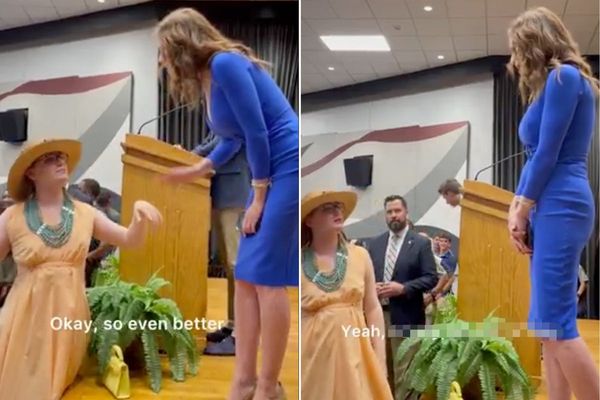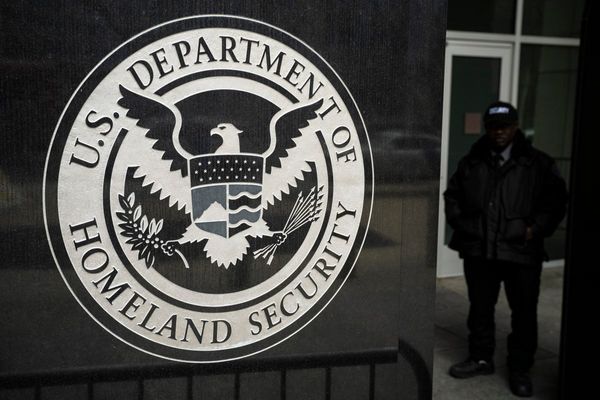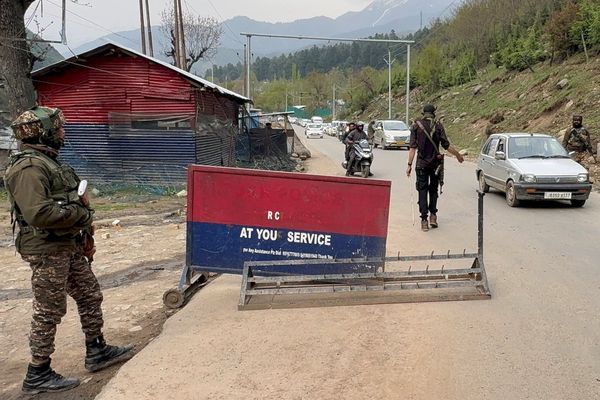BALTIMORE — Gunfire was so common in the block behind Mika Grant’s Northwest Baltimore home that she’d tell her children to avoid it. So when she heard dozens of shots one evening after her son had gone to the store, her heart sank.
Her worst fears were realized when she got to the scene: Her son, 14-year-old Amir Taylor, was caught in crossfire on his way home and was now headed to the University of Maryland Shock Trauma Center. He’d been shot in his arms and legs. With major artery damage, doctors told her he nearly didn’t survive the five-hour surgery that night in May 2021.
Amir spent weeks in the hospital and more in rehabilitation, missing a ceremony celebrating his move from middle to high school. He still has pain and sometimes multiple doctor’s appointments a week, and will need hip replacement surgery once he’s done growing.
“There is a lot of trauma in our communities; We’re not quite equipped to deal with trauma. Hurt people hurt other people,” Grant said.
At least five more teens were shot that month in the city, spurring calls for change by police and elected leaders. But kids kept getting shot.
More than 1 in 8 victims of gun violence taken to hospitals in Baltimore and surrounding counties involved children ages 10 to 19, an analysis of five years of hospital data by The Baltimore Sun found.
The injuries and deaths are taking an immeasurable emotional toll on families and communities. They also are a major public health concern, sending highly complex patients into a short-staffed pediatric health system that’s coping with other medical issues. When they’re discharged, wounded children return to homes in neighborhoods where they may feel unsafe.
The data, obtained from the state’s Health Services Cost Review Commission through a Maryland Public Information Act request, offers a window into gun violence that spans the region and is rising, as well, among adults. Hospital visits for gunshot injuries are at five-year highs for residents in the counties of Anne Arundel, Baltimore, Harford and Howard.
Federal statistics show firearms became the leading cause of death among children ages 19 and younger in 2020. In the first six months of 2022, the Kaiser Family Foundation tracked more than 300 mass shootings, including at a school in Uvalde, Texas, where 19 students died.
The coronavirus pandemic made matters worse. Public health, medical and crime experts cited myriad reasons, including isolation, as schools, community services and therapy were paused. Families suffered financial strains, sickness and loss.
For Baltimore, the pandemic came just a few years after the turmoil spurred by the death of Freddie Gray, a young Black man who died from injuries sustained in police custody, and a substantial reduction in arrests that followed.
Underlying it all, public health and crime experts say, is the availability of firearms. They believe some kids grow hopeless and hardened as trauma victims or witnesses — and easily find a gun. As Grant says: “Trauma begets trauma.”
“There is a prevalence of guns and ease of access to guns combined with a tremendous increase in stress and trauma,” said Adam Rosenberg, executive director of the Center for Hope, which LifeBridge Health opened earlier this year in Northwest Baltimore near Sinai Hospital to provide to trauma care for victims and families under one roof.
“Once upon a time when kids fought, they fought with words and fists. But when they reach the boiling point (now), the conflict results in gun violence,” he said. “If we don’t do something about it, it’s going to get worse.”
Altogether, there was a 13% increase in gun-related hospital visits in the region from 2016 to 2021.
Among the latest victims in Baltimore is a 13-year-old girl who was shot outside an East Baltimore liquor store and died Nov. 14.
Data suggest having guns contributes to violence. The most prevalent injury type among gun victims of all ages in Baltimore-area hospitals in each of the past five years has been unintentional, with 3,244 such cases in 2021. There were 1,476 assaults and 59 intentional self-inflicted wounds. Experts caution the data is dependent on how hospital staff code the injuries and is not necessarily a true measure of intentional versus unintentional shootings.
As well as LifeBridge, other institutions have stepped in to address the problem.
The University of Maryland, Baltimore, is starting a Center for Violence Reduction, aiming to pull expertise and clinical work from its medical, social work and law schools, as well as Shock Trauma.
“Until we as a society decide to tackle it in a serious way, it’s not going to get better,” Dr. Thomas M. Scalea, Shock Trauma’s physician-in-chief and the center’s leader, said at the September announcement of the center. “It’s not a political issue. It’s absolutely a public health issue. It is a terrible disease, and it’s a disease that we can treat, we can prevent.”
Researchers at the American Academy of Pediatrics have already found that keeping a gun at home at least triples the chance a child shoots someone or themselves.
Some 4.6 million kids nationwide live in homes with unlocked guns, according to the group.
There were an estimated 2,070 shootings by children from 2015 to 2020, and their rates of homicide and suicide increased by 75% from 2019 to 2020, the pandemic’s first year. Firearms deaths among children now surpass those from cancer and accidents.
There are, however, many other drivers of the violence. And the deaths are “just the tip of the iceberg,” considering there are so many more injuries, said Dr. Lois Lee, a Harvard Medical School associate professor of pediatrics and emergency medicine and chair of the academy’s Council on Injury, Violence and Poison Prevention.
“Mental health is a pivotal factor, and we know the pandemic’s affected that for many reasons, like social isolation, stressors inside and outside the home,” she said. “But a lot has to do with access. You can be suicidal, but if you don’t have access to a gun, you’re much less likely to kill yourself. And we know firearm sales increased dramatically during the pandemic.”
Poverty is a contributing factor, making kids less likely to have health care and mental health care and more likely to carry guns for protection, Lee said. Kids also are more impulsive.
Gun laws vary by state, she said. Maryland has stricter laws than some of its neighbors, but it’s difficult to stop the flow of firearms.
Daniel Webster, professor and director of the Johns Hopkins Center for Gun Violence Prevention and Policy, said violence is the result of “a set of forces that converge together.”
“Young people’s lives were really upended by the pandemic,” he said. “A lot of young people were left without structures and supports, and that contributes to violence.”
Webster noted that many cities experienced increases in violence in 2020 after widespread protests against police brutality following several high-profile deaths, including that of George Floyd, who was killed by Minneapolis police. Baltimore, which already had faced a reckoning following Gray’s death in 2015, had more peaceful protests.
“It was clear to me that both sides had learned hard lessons from 2015,″ Webster said of Baltimore.
And while Baltimore didn’t see the same major spike in violence as other cities that coincided with the pandemic, violence didn’t subside either. Homicides, mostly gun-related, have surpassed 300 every year since 2015, and gun cases at hospitals have ticked upward.
Joseph Richardson, a professor at the University of Maryland, College Park, studies the intersection of criminal justice and health care. He said violence continues in Baltimore because of “the exacerbated lack of trust in the police.”
Referring to the city’s ineffectiveness in solving homicide cases, he said: “The closure rate is 30%. So, you have 70% chance if you choose to injure or kill someone ... of getting away with it.”
Richardson also points to social media, such as Instagram, YouTube and TikTok.
“Beefs that are going on social media ... play out on the street,” he said. “You have these blurred lines between the digital street and the physical street.”
The violence involving youth in Baltimore spurred city officials to dedicate $500,000 a year to LifeBridge’s Center for Hope to maintain 24-hour services for children experiencing abuse and trauma or who witness someone being killed. City and school officials just started a school-based violence prevention program to identify at-risk kids and steer them to mediation to resolve disputes.
One of the schools in the program is Mergenthaler Vocational-Technical High School, where 17-year-old student-athlete Jeremiah Brogden died after being shot on school grounds in September. A student from another school is charged with killing him.
Richardson said such in-person violence intervention programs generally lost staff and funding during the pandemic.
As city and national leaders work to restart and expand programs, Richardson said even resource-rich cities struggle with coordinating efforts and tracking progress. He cited a Victim Services Capacity Assessment Report completed in 2021 and publicly released this year that detailed gaps in services for Baltimore shooting victims and families.
“People are not aware of what those resources look like or where to send people,” he said. “We’re not really tracking what happens to people after they are injured or what happens to them when they have been arrested for a firearm.”
As a result, people may drop through the cracks as resources are focused on medical care.
Bob Atlas, president and CEO of the Maryland Hospital Association, said more gunshot victims survive their wounds than in the past, but often require intensive treatment, plus long-term rehabilitative services.
“The trauma suffered by those individuals, their families and communities leads to diminished well-being and even more demand on health care services over the long term,” Atlas said.
There also is an economic toll. State data shows an inpatient emergency visit for gun wounds can cost tens of thousands of dollars to well over $100,000 a patient, much of it paid by taxpayers through Medicaid, the federal-state health care program for people with low incomes.
The problem is vast, but leaders insist the new programs can ease trauma and prevent more violence, even if some past efforts had mixed success.
Mujahid Muhammad, a longtime therapist in Baltimore, said he’s focused on African American kids in high-poverty areas of West Baltimore who are victims or witnesses of violence, intervening before they might go on to harm themselves or others.
More than 80% of the city’s gunshot patients are Black, state hospital data shows.
Muhammad said he first works to build trust, then coping mechanisms and confidence through his organization, KEYS Enterprises. It is partnering with Coppin State University on building a “Healing Village,” a space for therapists who will welcome kids with a meal or an activity.
He acknowledged that progress can be slow.
“Most people don’t come to a therapist and program ready for therapy,” he said. ”They come with a challenge or looking for love or something to do. We can’t chase them away before they want to sit on the virtual couch.”
Officials at the Baltimore Health Department said they take a holistic view of therapy. A program launched in 2016 provides aid to victims of trauma ages 11 to 24. It includes nontraditional assistance, such as rent, transportation and driving classes, to reduce burdens on families.
Mark Mason, director of the department’s Office of Youth and Trauma Services, said losing his nephew to gun violence gives him insight. He knows, for example, that kids often can’t advocate for themselves when they are hurting. He’ll go to their schools and ask teachers not to “mislabel” the kids simply as troublemakers when they have been a victim or witness to violence.
Sometimes, he helps kids change schools or families move to safer housing. He makes sure they can get to hospitals to see recovering family members. Mason also began what’s become an ambassadors program, where kids get vouchers for driving lessons if they join peer groups at school, where they learn to advocate for themselves and other kids.
“If you don’t intervene, everyone has the same understanding that someone has given up on them,” Mason said.
“They won’t ever forget the trauma, but they find ways to become resilient. They learn, ‘Someone is listening to me and helping me.’”
Grant credits the health department program for helping with rent and other necessities so she could stay at the hospital with Amir. She’s now focused on therapy for the family to help with the emotional wounds inflicted by someone they did not know and promoting nonviolent solutions and safer housing.
She said Amir is showing signs of his previous charming, funny and soulful self.
“He has this philosophical weight to him, and is always saying things that make me say, ‘Dang, I didn’t think of that,’” Grant said.
“He’s a funny guy, with dry humor, and when he’s not in a mood swing, he’s a caring uncle and brother,” she said. “He has amazing qualities, and I hope I can shine a light on them and he can see how not to just be negative.”
That’s what Terrence Jenkins has been doing, too, since his 17-year-old daughter, Jayla, and three other youths were shot in September 2021 in front of the family’s East Baltimore home by someone they didn’t know.
“How can you even say she was in the wrong place when she was in front of her house?” Jenkins said of Jayla, who recovered physically but suffers from the trauma.
Jenkins said the family home has since burned, complicating everyone’s emotional recovery. Jayla’s mother, father and siblings haven’t been able to find new housing and are staying with other family as they search with aid from the city officials.
Still, Jayla, whose last name is being withheld for her privacy, is “doing all the right things for her recovery and her future,” Jenkins said.
The level of violence confounds Jenkins.
What would help?“Getting people into houses in decent areas where they can live comfortably,” he said.
———







